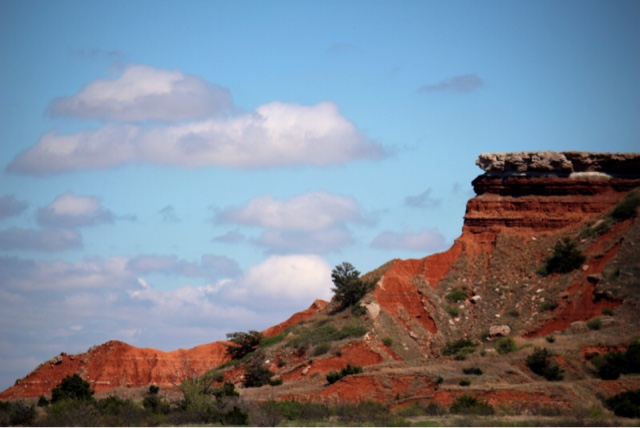Wednesday, May 25, 2016
Birthplace of Kermit the Frog Exhibit, Leland, Mississippi
Wednesday, May 18, 2016
Gloss Mountains, Fairview, Oklahoma
Wednesday, May 11, 2016
Bemidji, Minnesota
I love rocks. So no matter where I am or what I am doing, rocks can get me sidetracked. The nationally known Fireplace of States located in Bemidji’s Chamber of Commerce Tourist Information Center is made of over 900 rocks from all over the country. It all started in the early 1930s with an idea from Harry E. Roese, district manager of the Federal Reemployment Service, as well as president of the Civic and Commerce Association in Bemidji. His grand idea was of a fireplace containing rocks from every state in the union, from every Canadian province, from all 87 Minnesota counties, and from all the national parks. The building of the fireplace became one the New Deal projects designed to keep people working during the Depression.
A short sidetrack concerning Harry Roese: He was the owner of the classy Shorecrest Resort with the dance pavilion on Birchmont Drive.
He did not work alone. A secretary in Harry’s office, Miss Kathleen Wilson, was directed to write solicitation letters for the rocks. Fifty years later she still marveled at how willing people were to send their rocks to Bemidji, especially considering shipping costs of heavy rocks. As the rocks came tumbling in, each was numbered so an identification key could be compiled.
Mark Morse was the stone mason in charge of building and designing the fireplace. (If I were to go on a sidetrack now I would tell you about the Bemidji State University outdoor fireplace, the Greenwood Cemetery pillars, and Mark’s many other masonry projects in Bemidji).
By the end of 1935, the fireplace was completed as part of the octagonal Bunyan House on the shore of Lake Bemidji. For decades tourists admired the great fireplace and the many rocks.
As a sidetrack, I came across a 1939 newspaper article about Miss Elsie Mae Willsey acquiring some circa 1514 tiles in Puerto Rico, from the home of the Spanish Explorer Ponce de Leon, that she planned to bring back to Bemidji to be added to the fireplace. We are not sure about what happened to these. By the way (a sidetracked way), Elsie was a daughter of the well known Captain Willsey of early Bemidji renown, but that would be a whole ‘nother story.
By the mid-1990s, the building was in poor shape and needed to come down. But the great Fireplace of States was to be saved! It was segmented, shrink wrapped, and moved with a crane into the new Tourist Information Center next to the 1937 statues of Paul Bunyan and his blue ox, Babe. Visitors still love the impressive Fireplace of States. Go see it. The only thing missing is the key. The only rocks that we are certain of the origin are the ones that were engraved by the donors. But it is still worthwhile to check out!
For more information, visit: http://beltramihistory.org/2014/10/02/sidetracked-fireplace-of-states/
Bemidji, the First City on the Mississippi, is a historically charming, progressive northwoods city. Soon after its birth at Itasca State Park, the world’s fourth longest river- the Mississippi, travels north to Bemidji. After crossing through Lake Bemidji, it swings south on its 2,552- mile journey to the Gulf of Mexico.
History, diverse culture, legend and lore mingled with an abundance of bald eagles and waterways, give the Bemidji area its unique character. 400 fishing lakes in a 25-mile radius invite anglers and provide a variety of recreational opportunities all year around. The natural rhythm of changing seasons draw bikers, hikers, skiers and snowmobiling enthusiasts to the area’s State and National Forests. 400 miles of groomed snowmobile trails and 140 kilometers of cross country ski trails wind through the scenic north woods. Minnesota’s northwoods holds a treasure trove of natural beauty for those seeking peaceful refreshment.
For half a century, logging was the economic lifeblood of the area. By way of celebrating the turn-of-the 20th century booming industry, an 18 ft. statue of the legendary lumberjack Paul Bunyan and Babe his Blue Ox were constructed at the waterfront for the 1937 Winter Carnival. This famous duo has posed with visitors for countless memorable photographs ever since – earning Midwest Living magazine’s ‘‘Best in the Midwest” Roadside Attraction Award in 2003. Paul’s memorabilia, displayed in the adjacent Tourist Information Center, is sure to bring a grin.
Native American and Scandinavian cultures are woven together into the tapestry of Bemidji’s history. Several events and galleries showcase the community’s rich and diverse cultural heritage. A remarkable collection of sculpture and outdoor art throughout the downtown area offers a glimpse into the creativity this beautiful area inspires. Live performance theater, science and history museums and art galleries dot the downtown shopping and dining district.
Even though Bemidji is a regional retail and educational center, with the amenities of a large city, it still maintains a small-town atmosphere. The surrounding region abounds with interesting places and things to do. A few memorable places to visit are; the Headwaters of the Mississippi River at Itasca State Park, the Laurentian Continental Divide, the ‘Lost Forty’ forest of 350 year old trees, historic Camp Rabideau CCC Camp, birding hot spots and the Forestedge Winery.
Whether you are seeking a traditional vacation, a weekend getaway or want to enjoy your favorite sport, Bemidji is an ideal spot to relax and refresh.
For more information, visit: http://www.visitbemidji.com/

















